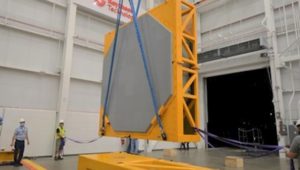Raytheon Technologies [RTX] delivered the first AN/SPY-6(V)1 radar array for the first Flight III DDG-51 destroyer, the company said Tuesday.
The SPY-6 radar system is also known as the Air and Missile Defense Radar (AMDR) and aims to provide improved performance for air and missile defense operations on the Flight III Arleigh Burke
-class destroyer. The Flight III ships are modified to be larger to house the radar systems and their power and cooling requirements.

The future USS Jack H. Lucas (DDG-125) will be the first Flight III destroyer.
Each Flight III destroyer AMDR will consist of four arrays, a power system, cooler, and back-end processor to compute array signals. Raytheon boasted the new radar is 30 times more sensitive than its predecessor on current destroyers.
“It’s like replacing a rooftop TV antennae with an HD digital receiver,” Jack Arbeiter, SPY-6 radar hardware lead for Raytheon, said in a statement.
The company said production of the remaining three arrays for DDG-125 are on schedule and the last one is expected to be delivered this October. Operational tests to evaluate system performance on the destroyer are set to begin in 2022.
HII is scheduled to deliver the Jack H. Lucas in FY 2023.
The individual array is 14 by 14 feet and was transported by truck from the company’s Radar Development Facility in Andover, Mass., to the Huntington Ingalls Industries [HII] shipyard building the ship in Pascagoula, Miss.
“SPY-6 will change how the Navy conducts surface fleet operations. Our ships will be able to see farther, react quicker and defend against threats in a way we couldn’t before,” Capt. Jason Hall, program manager for Above-Water Sensors for the U.S. Navy’s Program Executive Office for Integrated Warfare Systems, said in a statement.
Each SPY-6 radar for the DDG class ship includes four arrays, a power system, cooler to remove excess heat, and a back-end processor to compute array signals.
Production of the remaining radar arrays for the Jack H. Lucas is on schedule, with the last one expected to be delivered in October. Operational tests to evaluate system performance on the new ship is slated to start in 2022.
Raytheon said this is the start of a steady stream of SPY-6 array deliveries to the shipyard.
The company is contracted to build 36 SPY-6 arrays for nine destroyer AMDR shipsets over the next three years as part of low-rate initial production work.
The arrays will be delivered to both the HII shipyard and General Dynamics [GD] Bath Iron Works in Bath, Maine. The destroyers are built by both HII and GD.